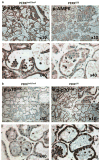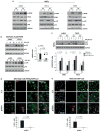Regulation of autophagy during ECM detachment is linked to a selective inhibition of mTORC1 by PERK
- PMID: 23160380
- PMCID: PMC3600386
- DOI: 10.1038/onc.2012.512
Regulation of autophagy during ECM detachment is linked to a selective inhibition of mTORC1 by PERK
Abstract
Adhesion to the extracellular matrix (ECM) is critical for epithelial tissue homeostasis and function. ECM detachment induces metabolic stress and programmed cell death via anoikis. ECM-detached mammary epithelial cells are able to rapidly activate autophagy allowing for survival and an opportunity for re-attachment. However, the mechanisms controlling detachment-induced autophagy remain unclear. Here we uncover that the kinase PERK rapidly promotes autophagy in ECM-detached cells by activating AMP-activated protein kinase (AMPK), resulting in downstream inhibition of mTORC1-p70(S6K) signaling. LKB1 and TSC2, but not TSC1, are required for PERK-mediated inhibition of mammalian target of rapamycinin MCF10A cells and mouse embryo fibroblast cells. Importantly, this pathway shows fast kinetics, is transcription-independent and is exclusively activated during ECM detachment, but not by canonical endoplasmic reticulum stressors. Moreover, enforced PERK or AMPK activation upregulates autophagy and causes luminal filling during acinar morphogenesis by perpetuating a population of surviving autophagic luminal cells that resist anoikis. Hence, we identify a novel pathway in which suspension-activated PERK promotes the activation of LKB1, AMPK and TSC2, leading to the rapid induction of detachment-induced autophagy. We propose that increased autophagy, secondary to persistent PERK and LKB1-AMPK signaling, can robustly protect cells from anoikis and promote luminal filling during early carcinoma progression.
Conflict of interest statement
The authors declare no conflict of interest.
Figures




References
-
- Raven JF, Koromilas AE. PERK and PKR: old kinases learn new tricks. Cell Cycle. 2008;7:1146–1150. - PubMed
Publication types
MeSH terms
Substances
Grants and funding
LinkOut - more resources
Full Text Sources
Other Literature Sources
Research Materials

